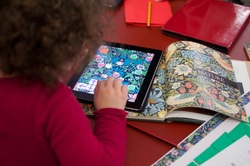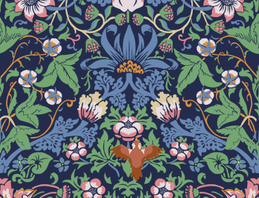 Photograph by Saskia Coulson
Photograph by Saskia Coulson Due to the great reception I've had to the Strawberry Thief prototype, I have decided to develop it fully. I'm now going to write briefly about some of my ideas and design decisions.
When I first got selected for this role at the museum, I already had an idea of the kind of objects I would be working from. I loved the iconic court dress in the rococo room, and was fascinated by the wood carvings of Grinling Gibbons. However, after about a month of exploring the galleries, it was the strawberry thief pattern that I wanted to base a game on. I'm happy that I picked a Morris' object, as he was very involved with the museum. Morris helped acquire objects for the museum, studied there, and was commissioned to design the V&A's dining room, which was the world's first museum cafe. His patterns are also heavily featured in the V&A Shop, covering tea towels, notebooks and more.
When I first got selected for this role at the museum, I already had an idea of the kind of objects I would be working from. I loved the iconic court dress in the rococo room, and was fascinated by the wood carvings of Grinling Gibbons. However, after about a month of exploring the galleries, it was the strawberry thief pattern that I wanted to base a game on. I'm happy that I picked a Morris' object, as he was very involved with the museum. Morris helped acquire objects for the museum, studied there, and was commissioned to design the V&A's dining room, which was the world's first museum cafe. His patterns are also heavily featured in the V&A Shop, covering tea towels, notebooks and more.

With my last game Tick Tock Toys, I started the design process by thinking about the mechanics first, and the context and visuals later. With this game however, my starting point was a existing piece of artwork. My main motivations and ideas for this game was to bring the pattern to life. My first thoughts were to take control of one of the birds, and to have the background repeating (to emphasise that its a repeating pattern that is used for furniture and wallpapers). Through various experiments, the idea turned into a game genre called 'Shoot-em-ups' or 'Shmups' What I like about this project is that I'm kind of taking a game genre, which is known for being difficult and having sci-fi themes, and (hopefully) turning it into something more accessible to the V&A's audience.
The most famous types of Shmups are by the Japanese company CAVE. I tried looking at other more accessible shmups, and found a game made by students called Solace. I am hoping to have an orchestral soundtrack for my game, so it is interesting to see how this game has used music.
The most famous types of Shmups are by the Japanese company CAVE. I tried looking at other more accessible shmups, and found a game made by students called Solace. I am hoping to have an orchestral soundtrack for my game, so it is interesting to see how this game has used music.
I have thoroughly play tested my small prototype with over 200 children by now, and have a good idea what I want to achieve with the game. I am now working on a game design document which will be used to communicate the game's content and mechanics to the team I will be working with in the summer. I will be sure to post the finished document on the blog, for students to look at. I am very excited to bring some of Morris' other patterns from the V&A into my game as different stages, and ideas for power-ups and enemies.
